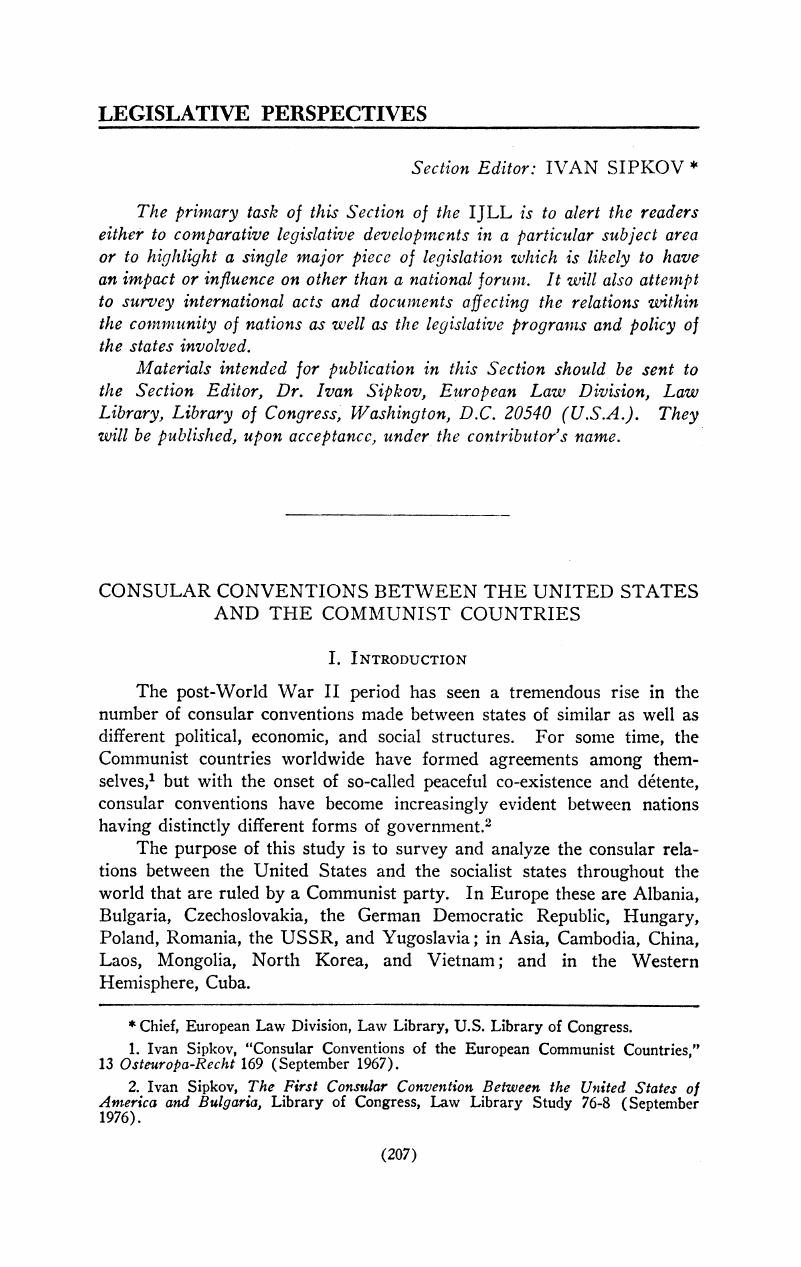No CrossRef data available.
Article contents
Consular Conventions Between the United States and the Communist Countries
Published online by Cambridge University Press: 13 February 2019
Abstract

- Type
- Legislative Perspectives
- Information
- Copyright
- Copyright © 1981 by International Association of Law Libraries.
References
1 Sipkov, Ivan, “Consular Conventions of the European Communist Countries,” 13 Osteuropa-Recht 169 (September 1967).Google Scholar
2 Sipkov, Ivan, The First Consular Convention Between the United States of America and Bulgaria, Library of Congress, Law Library Study 76-8 (September 1976).Google Scholar
3 25 UST 2597; TIAS 7927; 13 ILM 1436 (November 1974).CrossRefGoogle Scholar
4 18 ILM 274 (1979).Google Scholar
5 U.S. Department of State, 50 Bulletin 979 (June 22, 1964).Google Scholar
6 88th Congress, 2nd Sess., Senate Executive D.Google Scholar
7 21 UST 77; TIAS 6820; 596 UNTS 261; entered into force for the United States, December 24, 1969.Google Scholar
8 UN Doc. A/CONF. 25/13, April 23, 1963; 57 American Journal of International Law [AJIL] 993 (1963).Google Scholar
9 Countries and official law gazettes cited are abbreviated as follows:Google Scholar
** Bulgaria (B) — Dǔrzhaven Vestnik (DV)Google Scholar
** Hungary (H) — Magyar Közlöny (MK)Google Scholar
** Poland (P) — Dziennik Ustaw (DU)Google Scholar
** Romania (R) — Buletinul oficial (BO)Google Scholar
** Cuba (C), German Democratic Republic (GDR), United States (US), Union of Soviet Socialist Republics (USSR), Yugoslavia (Y).Google Scholar
** The Vienna Convention on Consular Relations is cited as VC.Google Scholar
10 The wording in VC, art. 4(1), is: “A consular post may be established in the territory of the receiving state only with that state's consent.”Google Scholar
11 Under VC, art. 20, in the absence of an express agreement on the size of the consular staff, the receiving state may require that this staff be kept “within limits considered by it to be reasonable and normal.”Google Scholar
12 US-R, art. 5.Google Scholar
13 Point 4, second sentence.Google Scholar
14 In general, the appointment and admission of heads of consular posts follow the provisions of VC, arts. 1-14.Google Scholar
15 US-B, art. 3(3).Google Scholar
16 US-B, art. 6; US-C, art. II, par. 2; US-H, art. 5(2); US-P, art. 7(1); US-R, art. 5(5); US-USSR, art. 2(6).Google Scholar
17 According to VC, art. 22, consular officers shall, in particular, have the nationality of the sending state. It also provides that persons having the nationality of the receiving state or third state may be employed, but with the “express consent of that state, which may be withdrawn at any time.” The term consular officer used in VC means “any person, including the head of a consular post” (art. 1(1) (d)).Google Scholar
18 US-B, art. 7; US-H, art. 6(1) (a).Google Scholar
19 US-P, art. 6(1); US-USSR, art. 3.Google Scholar
20 US-P, art. 6(1) (b).Google Scholar
21 US-R, art. 5(3).Google Scholar
22 Vedomosti SSSR, [official law gazette of the USSR], No. 27, item 404; entered into force on September 1, 1976. For text in English, see 2 Review of Socialist Law, No. 4, p. 235 (December 1976). See also Mironov, N. V., “Regulation by Law of the Consular Service in the USSR (The New USSR Consular Regulation of 1976),” 16 Soviet Law and Government, No. 2, p. 71 (Fall, 1977).CrossRefGoogle Scholar
23 Butler, W. E., “Soviet Consular Legislation,” 2 Review of Socialist Law, No. 4, 233-249, at 233 (December 1976).CrossRefGoogle Scholar
24 Gesetzblatt der DDR [official law gazette of the GDR] I, No. 40, June 1. 1957, p. 313.Google Scholar
25 US-H, art. 6(b).Google Scholar
26 Art. VIII.Google Scholar
27 Arts. V and X.Google Scholar
28 According to art. 25 of VC, termination of consular functions of a member of a consular post may also occur on notification to the sending state by the receiving state that it has ceased to consider that person a member of the consular staff.Google Scholar
29 US-B, art. 8; US-P, art. 8(1); US-R, art. 6(1); US-USSR, art. 2(7).Google Scholar
30 US-H, art. 7.Google Scholar
31 US-B, art. 8; US-USSR, art. 2(7).Google Scholar
32 US-H, art. 7; US-P, art. 8(2).Google Scholar
33 US-R, art. 6(2).Google Scholar
34 US-C, art. XVIII.Google Scholar
35 The wording in VC, art. 28, is that “the receiving state shall accord full facilities for the performance of the functions of the consular post.”Google Scholar
36 US-B, art. 9; US-R, art. 26; US-USSR, art. 4.Google Scholar
37 US-H, art. 30.Google Scholar
38 US-C, art. III; US-Y, art. II.Google Scholar
39 US-GDR, point 3, second and third sentences.Google Scholar
40 US-B, art. 15. Similar wording in VC, art. 40.Google Scholar
41 US-H, art. 8(1); US-R, art. 27.Google Scholar
42 US-B, art. 27; US-H, art. 19; US-R, art. 24; US-USSR, art. 27.Google Scholar
43 The problems of protection of consular officers; personal inviolability of consular officers; notification of arrest, detention, or prosecution; immunity from jurisdiction; and liability to give evidence are dealt with in VC, arts. 40-44.Google Scholar
44 US-H, art. 16(1); US-R, art. 29(5).Google Scholar
45 US-C, art. V, par. 1; US-Y, art. III.Google Scholar
46 US-B, art. 50(1); US-P, art. 13(4); US-R, art. 35; VC further states that “they also have a duty not to interfere in the internal affairs of the receiving state” (art. 55).Google Scholar
47 US-C, art. IV, par. 2.Google Scholar
48 US-USSR, art. 28. Similar wording is included in the US-P text, art. 13(4)., while the US-H one, art. 54(1), states: “including those relative to the control of traffic.”Google Scholar
49 US-B, art. 16(3) (c); US-P, art. 13(3) (b); US-R, art. 29(2) (b).Google Scholar
50 US-H, art. 15(2) (d).Google Scholar
51 US-H, art. 54(2); US-P, art. 22; US-R, art. 36.Google Scholar
52 US-B, art. 13; US-C, art. VII; US-H, art. 13(1); US-P, art. 11(1); US-R, art. 20; US-USSR, art. 17; US-Y, art. VI; VC, art. 33.Google Scholar
53 US-C, art. VII, par. 2; US-H, art. 13(2); US-USSR, art. 17.Google Scholar
54 VC, art. 35(2).Google Scholar
55 US-B, art. 14(3); US-P, art. 12(3); US-R, art. 21(3).Google Scholar
56 VC, art. 29.Google Scholar
57 Id.Google Scholar
58 VC, art. 31(1).Google Scholar
59 US-B, art. 50(2).Google Scholar
60 US-C, art. VIII; US-Y, art. VI.Google Scholar
61 VC, art. 35(1).Google Scholar
62 US-R, art. 21(4-5).Google Scholar
63 VC lists the consular functions in its art. 5.Google Scholar
64 US-H, art. 32(c).Google Scholar
65 US-GDR, point 3, fifth sentence.Google Scholar
66 VC in its art. 1 dealing with definitions does not provide them for “vessel of the sending and of the receiving state.”Google Scholar
67 U.S. Dept. of State, 50 Bulletin 979 (June 22, 1964).Google Scholar
68 Houston-Lay, , supra note 8, at 891.Google Scholar




